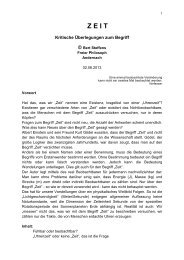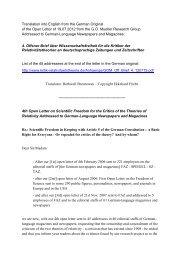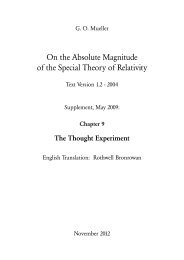2394 weitere kritische Veröffentlichungen - Kritische Stimmen zur ...
2394 weitere kritische Veröffentlichungen - Kritische Stimmen zur ...
2394 weitere kritische Veröffentlichungen - Kritische Stimmen zur ...
Erfolgreiche ePaper selbst erstellen
Machen Sie aus Ihren PDF Publikationen ein blätterbares Flipbook mit unserer einzigartigen Google optimierten e-Paper Software.
In: The general science journal. 2004 =<br />
http://wbabin.net/physics/asquith.pdf - 22 S.<br />
SRT. C-S. IS. SYMMETRIE. ZWP.<br />
Auszug: "The Twin Paradox. - The twin paradox<br />
raises concerns that all may not be well with the way<br />
the mathematics of special relativity has been interpreted.<br />
- A paradox is essentially nonsense. If sense could be<br />
made, there would be no paradox. Any mathematical<br />
analysis that ends in nonsense has to be reconsidered.<br />
The twin paradox is often demonstrated using the kcalculus<br />
and an asymmetrical spacetime diagram.<br />
(Figure 16). It has been shown that the algebra of the kcalculus<br />
is that of the transformation equations 26 to<br />
29. It follows that inertial frames Alex and Barbara can<br />
only be directly compared in a symmetrical model.<br />
Any conclusions drawn from direct comparison in an<br />
asymmetrical model (Figure 16) will be invalid.<br />
A symmetrical model (Figure 17) shows Alex and<br />
Barbara ageing the same. The Symmetrical Spacetime<br />
Model of Special Relativity has been shown to represent<br />
the transformation equations. Interesting questions have<br />
been raised about the measurement of time. It has been<br />
shown that there may not be a limit to achievable velocity.<br />
It has solved a longstanding paradox, the twin paradox."<br />
Assis, André Koch Torres 1998<br />
Mecânica relacional / André Koch Torres Assis; Centro<br />
de Logica, Epistemologia e Historia da Ciência. 1. ed.<br />
- Campinas, Brazil: Editora do Centro 1998. 349 S.<br />
(Coleção CLE. 22.)<br />
Engl. Übers. u.d.T.: Relational mechanics. 1999.<br />
Status: Kritik. - Quelle: GBV.<br />
Assis, André Koch Torres 1999<br />
Relational mechanics / Andre K. T. Assis. - Montreal:<br />
Apeiron 1999. 285 S.<br />
Translation of: Mecanica relational. - Vgl. Rez. von Phipps:<br />
Apeiron. 7. 2000, Nr. 1-2, S. 113-115. - Rez. von Chubykalo: S.<br />
115.<br />
SRT. ART. LORENTZ. ERK.<br />
Entwickelt im Rahmen der Darstellung einer eigenen<br />
Theorie (beruhend auf Webers Elektrodynamik) eine<br />
vernichtende Kritik beider Relativitätstheorien von Albert<br />
Einstein.<br />
S. 125-146: Einstein's special theory of relativity.<br />
S. 147-157: Einstein's general theory of relativity. -<br />
Faßt seine Kritik zussammen (S. 157-159: General<br />
comments):<br />
(1) "They [Einstein's special and general theories of<br />
relativity] are based on Lorentz's formulation of<br />
electrodynamics, which suffers from asymmetries<br />
pointed out by Einstein and many others. These asymmetries<br />
do not appear in the observed phenomena of<br />
induction."<br />
(2) "Einstein's special theory of relativity maintains<br />
the concept of absolute space and of inertial frames<br />
disconnected from distant matter. Moreover, it introduces<br />
another absolute entity, namely, the velocity of<br />
light in vacuum. Nothing in physics leads to the conclusion<br />
that light velocity should be constant irrespective<br />
of the motion of the observer or of the detector. All<br />
velocities known to us are constant relative to the source<br />
(like bullets) or constant relative to the medium (like<br />
sound velocity which is constant relative to air, irrespective<br />
of the motion of the source). Bu all of them vary<br />
according to the motion of the obsewrver or detector.<br />
To assert the opposite, as Einstein did, can only lead to<br />
the necessity of introducing strange and unnecessary<br />
concepts in physics such as time dilation, contraction<br />
of lengths, proper times etc."<br />
(3) "Einstein begins to interpret the velocity in<br />
Lorentz's force as the velocity of the test charge relative<br />
to the observer (and not to the dielectric in which the<br />
charge is moving, nor to a special frame like the ether,<br />
nor to the magnet or current-carrying wire generating<br />
the magnetic field). This Einsteinian point of view is<br />
contrary to the interpretations of Thomson, Heaviside<br />
and Lorentz. No experiment forced this new interpretation<br />
of the terms appearing in the basic force law.<br />
The induction of currents discussed by Einstein was<br />
known since 1831, while Thomsons's paper is from<br />
1881. Thomson (1881), Heaviside (1889) and Lorentz<br />
(1895) maintained different interpretations although<br />
dealing with the same experiments."<br />
(4) "Einstein correctly pointed out that the best way<br />
to implement Mach's principle was to utilize only the<br />
distance between interacting bodies and their relative<br />
velocities and accelerations. Unfortunately he himself<br />
did not follow this route because he thought it was<br />
impractical."<br />
(7) "General relativity cannot explain Newton's<br />
bucket experiment in all frames of reference, contrary<br />
to what happens in classical mechanics."<br />
(8) "In our view, the theoretical concepts of length<br />
contraction, time dilation, Lorentz invariance, Lorentz<br />
transformations, covariant and invariant laws, Minkowski<br />
metric, four-dimensional space-time, energymomentum<br />
tensor, Riemannian geometry applied to<br />
physics, Schwarzschild line element, tensorial algebras<br />
in four-dimensional spaces, quadrivectors, metric tensor<br />
g[my,v], proper time, contravariant four-vectors and<br />
tensors, geodetic lines, Christoffel symbols, super<br />
strings, curvature of space, etc. have the same role as<br />
the epicycles in the Ptolemaic theory."<br />
Atsiukovskii, Vladimir Akimovich 1990<br />
Obshchaya efirodinamika [General etherdynamics]:<br />
modelirovanie struktur veshchestva i polei na osnove<br />
predstavlenii o gazopodobnom / V. A. Atsiukovskii. -<br />
Moscow: Energoatomizdat 1990. 277 S.<br />
Status: Kandidat. - Quelle: LOC.<br />
Textversion 1.2 - 2012 53<br />
G. O. Mueller: SRT Kap. 4-Erg..





